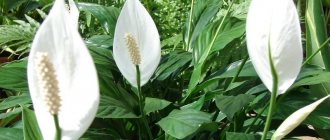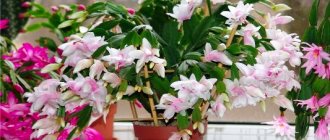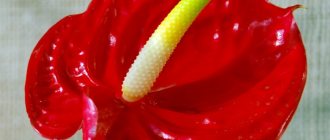- November 11, 2019
- Flowers
- Michael Michaelis
"Women's happiness", or spathiphyllum, is a fairly common indoor plant. This is due to its beauty and unpretentiousness. In our article we will talk about what the “female happiness” flower is, how to care for it so that it blooms, what fertilizers to add to the soil, how many times a week to water, and so on. This information will be especially useful for beginning gardeners. Although professionals will certainly be able to highlight several interesting points for themselves.
Watering rules
A rather moisture-loving tropical plant is what the “female happiness” flower represents. “How to care for it to bloom?” - a fairly common question among novice flower growers. However, professionals know that all tropical crops enter the flowering phase only if they receive enough moisture. The need for watering is indicated by the condition of the substrate. As soon as the top crust dries, it’s time to add water to the soil.
Despite the fact that the crop is moisture-loving, it should be watered with great care. The flower has an extremely negative attitude towards waterlogging, because this provokes the development of fungal infections inside the root system. To avoid accidentally overwatering the flower, you should carry out the procedure in small portions. As soon as you see that water has begun to accumulate in the pan, remove the watering can to the side. The drainage layer will also avoid waterlogging.
Many novice flower growers also ask the question: “The leaves on the “female happiness” flower are drying - what to do?” It is worth understanding that such a “symptom” is not always caused by insufficient watering. Sometimes the reason lies in dry air, and the gardener mistakenly begins to water the pot, which already contains a sufficient amount of moisture. To prevent this from happening, you should water the crop no more than 3 times a week in the summer and 1 time a week in the winter.
What should you not do?
A big problem when caring for spathiphyllum is overwatering. Excessive moisture in the pot can be detrimental to the plant. Excess moisture may indicate poor drainage.
What else is considered improper watering:
Stick to certain days or dates, regardless of the condition of the ground.- Moistening the flower with cold, ice water.
- Frequent watering when indoor temperatures are low.
- Wait until the soil dries completely.
- Lack of watering for more than 5 days is critical for spathiphyllum.
Soil for planting
Watering the “female happiness” flower (spathiphyllum) is far from the only issue that worries gardeners. After all, a plant just purchased in a store will first need to be planted somewhere. To do this, you need to prepare a high-quality substrate, which will consist of 2 parts turf soil, 1 part leaf soil, 1 part coarse sand and 1 part peat. It is also recommended to add 0.5 parts of crushed charcoal to the substrate. As an alternative, a ready-made substrate for aroid crops, which can be purchased in a store, is well suited.
It is also important to remember that the root system of spathiphyllum is extremely delicate, so only a substrate that has an airy structure is suitable for planting. Otherwise, the flower will grow very slowly. However, there is a little trick that will give the earthen mixture some airiness. You just need to add a little sawdust (not shavings) or ground brick. For every kilogram of soil there should be approximately 100 grams of this component.
Replanting after purchase
Many novice gardeners ask the question: “Why should I replant a plant I just bought, because it was in the store, which means it was grown under optimal conditions.” However, only those who do not know that store-bought soil is not intended for constant growth can think this way, since it contains a huge amount of nutrients that support the decorative appearance of the crop. However, if she is raised in such conditions for too long, she will definitely get sick. To transplant the “female happiness” flower (spathiphyllum), it is recommended to use the transshipment method.
- Carefully remove the flower from the pot along with the earthen lump.
- We place the flower in a new container, which is 2-3 cm larger than the old one.
- Add pre-prepared soil mixture to the container.
- Water the plant generously with settled or rain water.
Further care must be carried out with special care. To do this, it is important to look closely at indicators that signal a lack of nutrients, sunlight or water. However, it is worth understanding that if the flowers dry on the “female happiness” flower, then this is not yet a reason to sound the alarm and add growth stimulants to the soil. It’s just that in some cases it takes a culture a long time to acclimatize to new conditions. And the drying out of the buds is a completely normal reaction for the “female happiness” indoor flower. How to care for the crop? Read about this in the following sections.
Consequences of wrong actions
When overmoistened
A common cause of death of indoor plants is soil flooding. Therefore, you need to moisturize spathiphyllum in moderation. With too much moisture, the roots cannot breathe and the process of rotting begins.
Important! Excess water can lead to mold and fungal diseases.
External signs of soil waterlogging:
- the stem becomes soft;
- mold appears on the ground;
- the plant withers;
- the leaves turn black and dark spots appear on them.
If this happens to a flower, you should urgently replant it. Remove rotten parts of the plant and disinfect the cuts. Still diseased spathiphyllum should be treated with a fungicide solution.
Insufficient watering
Dry soil is also not the best option. Lack of life-giving moisture negatively affects appearance, flowering, and foliage growth. The plant begins to gradually dry out, and returning it to its previous state is not so easy.
Symptoms of lack of fluid: yellow tips and limp leaves that turn yellow and dry over time. The first thing to do in such a situation is to take a warm shower. To soak the soil with moisture, moisten the foliage.
When using poor quality water
Another consequence of improper watering is yellow tips on the leaves and the appearance of white spots. This phenomenon is associated with poor quality water. Humidification with hard water containing a lot of salts can cause similar symptoms. Actions to eliminate the disease:
- Rinse the roots under running water.
- Remove the white coating from the leaves.
- Renew the soil and replant the flower.
- In the future, use purified water.
A place to grow a flower “female happiness”
“How to care for it to bloom?” – this question can be seen quite often on various forums for gardeners, asked by beginners to professionals. The answer to this can be quite different, but most experts recommend that you first pay attention to choosing the optimal location for growing the crop.
It is best to give preference to a room that has a window facing east or west. It is also strongly recommended not to place a pot with a plant on window sills or balconies, where there is no additional source of shading. The culture loves sunlight very much and without it will never enter the flowering phase. But direct rays will burn delicate leaves, so in the summer you should use tulle or a special garden net, the shading level of which is 50%.
It is not recommended to place the culture in rooms with strong drafts, as this can provoke the development of a dangerous disease - powdery mildew. Although the flower still loves fresh air. So place the flowerpot on some high surface (there will be a draft across the floor) and be sure to close the window before you decide to spray. Otherwise, the drops of moisture on the leaves will cool, after which a white coating will begin to form on the plates.
Air humidity and swimming
Caring for “female happiness” at home also involves regularly spraying the leaves with a spray bottle. Tropical crops love moist air, so you will have to do this at least 3-4 times a week. You just need to set the tool to spray mode so that the droplets falling on the foliage are very small. If you don’t have time for frequent spraying, you can place a steam generator or a three-liter jar next to the flowerpot with expanded clay at the bottom (the stones will increase the intensity of liquid evaporation by almost 10 times).
To give the flower a decorative appearance, you can also start wiping it regularly with a sponge dipped in water. This procedure can be carried out every day in the summer and about a couple of times a week in the winter. It can also be replaced with a regular cold shower. However, don't overdo it with your bath! This should be done no more than once a month in the summer and once every 2 months in the spring and autumn. The water temperature for swimming should be at least 30 degrees Celsius.
Traditional methods
Returning to the question of how to water spathiphyllum, it is important to decide on the technique. The following are very popular:
- External humidification to maintain optimal air humidity - for this, a flowerpot with a flower is placed in a container with constantly moistened pebbles or moss, or a special air humidifier is installed near the plant.
- Spraying on the leaf is necessary all year round (and even in winter) with a certain regularity (more often in the spring-autumn period (from 2 to 5 times a day), less often from November to March (optimally every other day)). It is important to be careful not to get the liquid directly into the middle of the growing area.
- Overhead showering - once a month it is good to water the flower from the shower with warm water (35...40 °C), which will imitate the natural precipitation of the hot tropics. The method solves two problems: it washes away dirt and nourishes the greens. The technique requires caution during the flowering period (water should not be allowed to get on the bud).
- The traditional root method is gentle watering at the root of the flower, bypassing the above-ground parts. Water is added carefully along the walls of the pot, avoiding exposing the rhizomes. You can use a watering can with a “shallow shower” attachment.
- The drainage method is the best option if you have to leave the spathiphyllum for a long time without top watering. When going on a business trip or vacation, first place the flower pot in a deep basin filled with water. It is important to make sure that the flowerpot has a drainage hole, since moisture will flow to the roots through it.
After the moistening procedure, the soil inside the pot is loosened, and the remaining water in the pan must be drained so as not to provoke the development of fungi and mold.
The plant also responds well if its foliage is periodically carefully wiped with a damp sponge. This will get rid of accumulated dust and additionally nourish the foliage with moisture.
Organic and mineral supplements
Don’t know what to feed the “female happiness” flower? Most professionals recommend using complex mineral supplements for this purpose, which contain nitrogen, phosphorus and potassium. In addition, when reading the composition, it is important to pay attention to the content of copper, manganese and iron in the preparation, since these microelements have a beneficial effect on the health of the crop and its growth rate. However, dilute the tablets or essence in water strictly according to the instructions, since an excess of components can be much more dangerous than their deficiency.
As for organic fertilizers, they are used only in extreme cases and exclusively by professional gardeners. If a flower lacks a certain microelement, for example, nitrogen, then professionals can dilute organic matter (manure, urea) to compensate for its deficiency. It’s just not advisable to use organic matter during the period of bud formation and flowering. In addition, without proper experience, you should refrain from using such fertilizers, since exceeding the dosage can simply kill the plant.
It is best to fertilize in the spring, when the plant begins to emerge from winter hibernation. It is important to dilute the fertilizing with water and then pour it directly under the root (some preparations have the ability to be sprayed on the leaf). After this, it is forbidden to replant the crop to a new location for several weeks. In addition, a few days before feeding, it is recommended to refrain from watering, even if the substrate is quite dry. The more the spathiphyllum “gets hungry”, the better it will absorb all the microelements added to the soil along with the next fertilizing.
When should we expect the first flowering?
It is worth understanding that the home flower “female happiness” enters the flowering phase only if the grower provides proper care. For example, the crop does not like being watered with cold water or placed in dark areas. In addition, too low a temperature in the spring (below 18 degrees) will provoke a long awakening of the plant after hibernation, as a result of which flowering may not occur at all.
“Women's happiness” blooms only in the warm season (from April to September). The chance that a flower will delight you with its decorative appearance can increase several times if you regularly fertilize the soil with mineral fertilizers. Particular attention should be paid to the content of phosphorus and potassium (nitrogen is necessary for the formation of green mass). Another very common reason why spathiphyllum does not bloom is that the pot is too narrow.
Helpful information
The flower is a herbaceous perennial. Spathiphyllum has no stem; the leaves begin to grow from a short rhizome and form a rosette. First, a petiole is formed, then it stretches out and becomes narrower towards the top, topped with a beautiful leaf. The height of the flower on average reaches 40 cm, but there are also meter-long giants.
“Women's happiness” grows quickly; in one season the rosette becomes twice as thick due to the large number of young leaves. In spring, tall and strong peduncles form from the axils. The flower has the shape of a spadix, wrapped on top with a white veil. Lasts up to 10 weeks, then turns green and dies. Flowering ends by mid-autumn, the plant goes dormant, but does not shed its leaves.
What diseases should you be wary of?
It is worth noting that the home flower “female happiness” has fairly good resistance to various bacterial infections and other diseases characteristic of other ornamental crops. However, this does not mean that you should neglect the basic rules of care. After all, this is what most often leads to the plant becoming sick. Below are the main “illnesses” that you should be most wary of.
- Root rot. A very dangerous fungal infection that in most cases cannot be treated. To avoid the appearance of this “disease”, you should carry out high-quality watering. In no case should moisture stagnate in the pot, since this is what provokes the development of infection. The only chance to save the affected flower is to transplant it into a new pot and remove those parts of the root system that were affected.
- Powdery mildew. Another “illness” that is the result of improper care. It can be triggered by cold water on the leaves. So it is strongly not recommended to spray a plant that is in a draft or outdoors. Otherwise, a white coating will begin to appear on the leaf blades, which can only be dealt with with the help of fungicides.
- Apex rot. The disease is accompanied by drying of the leaf blades and their gradual falling off. First, the infection affects exclusively the upper part of the leaf, after which it spreads over the entire area. An inexperienced gardener may assume that such a “symptom” is associated with a lack of water in the soil, although in reality the disease appears in conditions of too dry air.
Spathiphyllum diseases
Insect pests
Sometimes spathiphyllum is disturbed by aphids and spider mites. You can combat these pests by wiping the leaves of the plant with a soap solution containing nicotine sulfate. Before treatment, cover the soil in the pot with film so that the solution does not get into the substrate; after a day, the drug must be washed off the leaves, again covering the substrate in the pot with film. If you don’t want to deal with pests, make it a rule to regularly wash spathiphyllum leaves or wipe them with a damp sponge.
Spathiphyllum turns yellow
Before answering the question why the leaves of spathiphyllum turn yellow, you need to find out whether all the conditions for keeping the plant are met by you, because, as a rule, it is the violation of the rules of agricultural technology that is the cause of the disease. The reason that the spathiphyllum turns yellow and withers may be your forgetfulness: you need to maintain regularity in watering, the soil should not dry out. If this happens, start watering little by little to soak the dry soil, and increase the amount of water gradually.
If the reason is not watering, but insufficient air humidity, then you yourself know how to eliminate it: spraying, wiping the leaves with a damp sponge, a tray with wet expanded clay... If the yellowness of the leaves appears due to the activity of pests, study the previous section.
Spathiphyllum turns black
If the leaves of a spathiphyllum turn black, this often means that the plant’s root system is dying. This happens as a result of systematic waterlogging of the soil or spraying of the plant in a too cool room. Remove the plant from the substrate and carefully examine the roots: if they have not yet rotted, remove those that cannot be saved, replant the plant in a new substrate, and perhaps this will save its life. Just draw your own conclusions from this situation and don’t allow it to happen again.
Sometimes blackness on the leaves indicates that its nutrition is unbalanced: either the plant suffers from a lack of nutrition and the blackness on the leaves shows you its discomfort, or you overdid it with fertilizers. Read the section on fertilizing again and you will understand what you are doing wrong.
Spathiphyllum dries
Why do the tips of spathiphyllum leaves dry out? If the air in the room is too dry or too cold, with a simultaneous lack of nutrition, the tips of the leaves begin to dry out in the plant. Eliminate these deficiencies in care, and gradually everything will get better.
Spathiphyllum does not bloom
There may also be several answers to the question of why spathiphyllum does not bloom, and the reasons, as in other problematic cases, must be sought in violation of the rules for caring for the plant. Find errors and fix them. If you do everything correctly, the reason may be that the pot is too spacious - the spathiphyllum will not bloom until its roots fill the entire container. Transplant it into a smaller pot and keep it cold for a couple of weeks - at 12-15 ºC. This will cheer up your lazy one, and he will definitely bloom.
List of pests
However, infections are far from the main problem for “women’s happiness.” No less a threat to the plant can be posed by parasitic insects, which suck the vital juices from the leaves and stems, after which the plant gradually begins to wither and dies. Below are the main pests, as well as methods of controlling them.
- Spider mite. The difficulty in controlling this insect lies in its microscopic size. You are unlikely to notice the parasite until it has developed an entire colony on the plant. In order to actively grow and reproduce, insects must feed on juices obtained from leaf plates and stems of indoor crops. To combat the pest, an insecticide should be used immediately.
- Aphid. Another common type of parasite that can cause serious problems for any gardener. The most unpleasant fact is that insects reproduce at tremendous speed. In just a few days they can infect even a mature plant so severely that it never recovers. To combat aphids, it is customary to use a solution of green soap.
- Chervets. Another microscopic parasite that appears on the leaves of a plant if it is grown outdoors or is often exposed to heavy rain. The parasite can be recognized by the mucus that the leaves of the plant begin to secrete. To combat, you can use any insecticidal agent or a special decoction based on wormwood, a herb that has powerful antiparasitic properties.
Diseases that occur due to improper watering
When watering a plant, you should always carefully inspect the leaves. They are the indicators of the health of the flower. The appearance of diseases is promoted not only by improper watering, but also by parasites. Most often this is:
- Shield aphids (or scale insects) - usually located on the back of leaves and on stems. It feeds on the sap of the plant, which first leads to dark spots, then completely drying out and dying of the leaf.
- Mealybug - most often appears if the flower is flooded with water. A humid environment is ideal for this pest. You need to look for it between the leaves and on the stems
- Spider mite - this pest can be considered the most unpleasant and dangerous. It sucks the juice from the plant, entangling the leaves with a small whitish cobweb.
- Sooty fungus - spreads on the surface of the leaf in the form of dark spots. Under these spots the plant can neither breathe nor grow.











